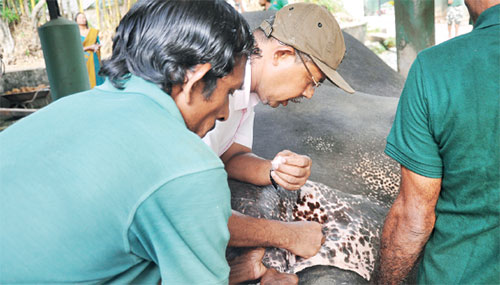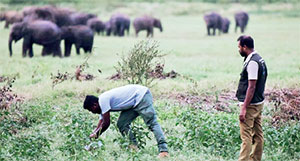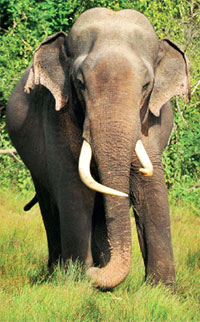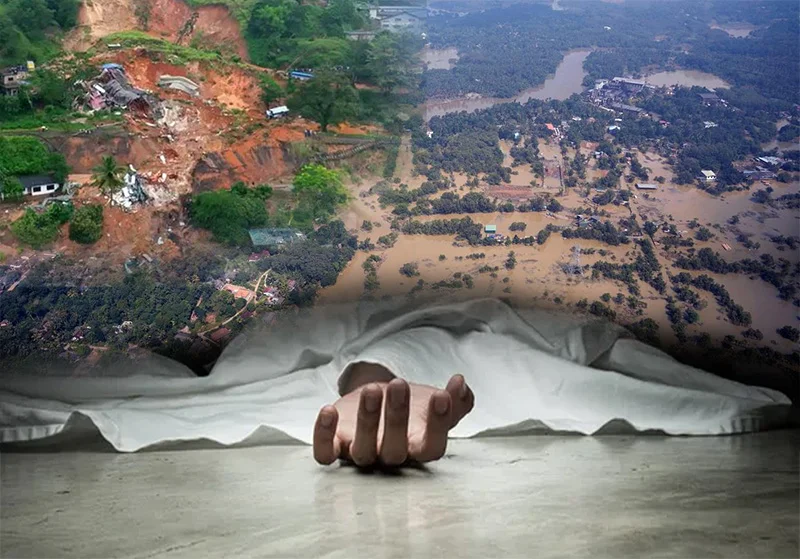News
Scientific team completes part of ongoing study on gene pool of 700 Lankan elephants

by Ifham Nizam
An eight-member scientific team has completed a comprehensive part of an ongoing study on the gene pool of 700 Sri Lankan elephants.
Department of Wildlife Conservation (DWC) and Agricultural Biotechnology Centre (AgBC) of the University of Peradeniya, are conducting a research on DNA analysis of wild elephants in Sri Lanka funded by the Ecosystem Conservation and Management Project (ESCAMP).
The scientific team comprises Ranjan Marasinghe, R. M. R. Nilanthi Rajapakse, H.A. Bhagya Hathurusinghe, Chandana Sooriyabandara, Dr. C. H. W. M. R. Bhagya Chandrasekara, Nuwan Jayawardana, M. Madawika Kodagoda, Dr. R. C. Rajapakse and Prof. Pradeepa. C. G. Bandaranayake.
 “The study will clearly indicate the differences of the Sri Lankan elephant as a sub species. Our molecular methodology is based on using elephant dung, and the test is similar to the Covid-19 PCR test”, Researcher R. M. R. Nilanthi Rajapakse told The Sunday Island.
“The study will clearly indicate the differences of the Sri Lankan elephant as a sub species. Our molecular methodology is based on using elephant dung, and the test is similar to the Covid-19 PCR test”, Researcher R. M. R. Nilanthi Rajapakse told The Sunday Island.
“We have already sequenced and assembled the genome of the Sri Lanka Wild Elephant (Elephas maximus maximus), the type subspecies of the Asian elephant. Comparative genomics work continues with available Asian and African elephant genomic data with the objective of identifying specific set of markers for the identification of Sri Lankan elephants”, the team said.
The first part of the research focused on 100 elephants, and it has now increased to 700 with continued focus on elephants in the forest patches etc., they remarked.
The project aims to examine the within-species genetic structure of the wild elephant across its range to better understand how genetically distinctive regional populations are and deviations of Sri Lankan elephants with those of other countries and how that might affect its conservation.
Conservation and management of elephants in Sri Lanka has become an important issue given the escalation of the Human-Elephant Conflict (HEC) and international trade of wild elephants.
The Asian elephant, Elephas maximus, is an umbrella species in tropical forests. Wild elephants play important roles in maintaining forest dynamics such as opening animal trails in the forests, creating open gaps that facilitate seed and acting as a seed disperser for large-seed fruit species. The conservation status of the Asian elephant has been recognized as an endangered species since 1986. Wild Asian elephants are currently distributed mainly in the South and Southeast Asia.
Habitat loss and fragmentation, anthropogenic disturbance, illegal poaching and HEC have been considered as significant threats to the Asian elephants, resulting in population decline and fragmentation. These threats resulted in skewed sex ratio and disruption of social organization.
 Acquiring information of wild populations is important for effective conservation and management of wild elephants.
Acquiring information of wild populations is important for effective conservation and management of wild elephants.
Wild elephants in Sri Lanka is estimated to be between 5,000 and 6,000, according to the last survey conducted by the DWC in 2011. This is a relative high number considering the small size of the country (65,610 sq. km) and the human population of over 21 million.
For management of elephants in the wild, monitoring the changes in the structure and composition of the populations would be far more useful than estimating elephant numbers.
Therefore, genetic methods will be useful for management and conservation plan such as individual and sex identification, population size estimation, population sex ratio, genetic diversity, relatedness among individuals in a population, gene flow among populations, detection of bottleneck event, phylogeography of particular species, detection of hybridization, providing evidence of illegal wildlife poaching, including being a tool for genetic management of a population and long-term monitoring of the managed population.
It provides genetic information of the populations that could not be obtained from field data collection alone. Genetic methods, on the other hand, provide reliable information on population structure and facilitate investigation of genetic effects on small and fragmented populations. Advance genetic methods also provide better estimations on population size with reasonable cost and time.
Further, tracking of ivory poaching would also be possible if a reference genetic database of the natural populations is available.
Molecular genetics studies on elephants’ date back to 1990s. Micro satellite markers have been the preferred choice and have played a major role in ecological, evolutionary and conservation research on elephants over the past 20 years.
However, technical constraints especially related to the specificity of traditionally developed micro satellite markers have brought to question their application, specifically when degraded samples are utilized for analysis. Therefore, the team analyzed the specificity of 24 sets of micro satellite markers frequently used for elephant molecular work.
“First, we optimized the DNA extraction protocol for elephant dung which can even be used for samples reach the lab within a week’s time because all previous studies depended on fresh dung samples collected less than 24 h time”, the team said.
“Comparative wet lab analysis was done with blood and dung DNA in parallel with in silico work. Our data suggest cross-amplification of unspecific products when field-collected dung samples are utilized in assays. The necessity of Asian elephant specific set of micro satellites and or better molecular techniques are highlighted”, the team pointed out.
The necessity of insilico analysis for testing specificity of SSRs is highlighted for other wild animals, for example, leopards. Nevertheless, the current study suggests that the analysis should extend beyond the human genome especially when dung DNA is used as starting materials. Therefore, the specificity of primers is a critical factor deciding the success of traditional SSR based methods adopted for such analysis.
Based on their study, no primer set out of 24 tested SSRs could be recommended for future work when the elephant dung is used as the starting material. If blood samples are drawn carefully with no human or other contamination, those with no multiple hits in the elephant genome, for example, EMU06 and EMU07 could still be used. As such, results of the previous studies done with elephant dung would be questionable with the evidence gathered from current findings.
“Nevertheless, no one could challenge the past since the revolutionary technologies pawed the path for the success of current studies. However, our results suggest the necessity of revisiting available methods. Alternatively, more specific,” the team stressed.
News
Cyclone Ditwah leaves Sri Lanka’s biodiversity in ruins: Top scientist warns of unseen ecological disaster

Sri Lanka is facing an environmental catastrophe of unprecedented scale in the wake of Cyclone Ditwah, with leading experts warning that the real extent of the ecological destruction remains dangerously under-assessed.
Research Professor Siril Wijesundara of the National Institute of Fundamental Studies (NIFS) issued a stark warning that Sri Lanka may be confronting one of the worst biodiversity losses in its recent history, yet the country still lacks a coordinated, scientific assessment of the damage.
“What we see in photographs and early reports is only a fraction of the devastation. We are dealing with a major ecological crisis, and unless a systematic, science-driven assessment begins immediately, we risk losing far more than we can ever restore,” Prof. Wijesundara told The Island.
Preliminary reports emerging from the field point to extensive destruction across multiple biodiversity-rich regions, including some of the nation’s most iconic and economically valuable landscapes. Massive trees have been uprooted, forest structures shattered, habitats altered beyond recognition, and countless species—many endemic—left at risk.
Among the hardest-hit areas are the Royal Botanical Gardens, Peradeniya, Seethawaka Botanical Garden, Gampaha Botanical Garden, and several national parks and forest reserves under the Department of Wildlife Conservation and the Forest Department. Officials describe scenes of collapsed canopies, destroyed research plots, and landscapes that may take decades to recover.
Prof. Wijesundara said the scale of destruction demands that Sri Lanka immediately mobilise international technical and financial support, noting that several global conservation bodies specialise in post-disaster ecological recovery.
“If we are serious about restoring these landscapes, we must work with international partners who can bring in advanced scientific tools, funding, and global best practices. This is not a situation a single nation can handle alone,” he stressed.
However, he issued a pointed warning about governance during the recovery phase.
“Post-disaster operations are vulnerable to misuse and misallocation of resources. The only safeguard is to ensure that all actions are handled strictly through recognised state institutions with legal mandates. Anything else will compromise transparency, accountability, and public trust,” Prof. Wijesundara cautioned.
He insisted that institutions such as the Department of Wildlife Conservation, the Forest Department, and the Botanical Gardens Department must take the lead—supported by credible international partners.
Environmental analysts say the coming months will be decisive. Without immediate, science-backed intervention, the ecological wounds inflicted by Cyclone Ditwah could deepen into long-term national losses—impacting everything, from tourism and heritage landscapes to species survival and climate resilience.
As Sri Lanka confronts the aftermath, the country now faces a critical test: whether it can respond with urgency, integrity, and scientific discipline to protect the natural systems that define its identity and underpin its future.
By Ifham Nizam
News
Disaster: 635 bodies found so far, 192 listed as missing

The Disaster Management Centre (DMC) has categorised 192 persons as missing as search operations were scaled down in flood-affected areas.
The death toll has been placed at 635, while the highest number of deaths was reported from the Kandy District. Kandy recorded 234 deaths.
According to the latest data, a total of 1,776,103 individuals from 512,123 families, in 25 districts, have been affected by the impact of Cyclone Ditwah.
The DMC has said that 69,861 individuals from 22,218 families are currently accommodated in 690 shelters established across the country.
News
H’tota Port says it was fully operational during extreme weather

As Sri Lanka experienced one of the worst flood situations in its recorded history, which crippled national infrastructure and forced operations to suspend at the Port of Colombo, Hambantota International Port (HIP), however, remained fully operational, the HIP has said in a media statement. Although Hambantota also faced heavy rains, it lay outside the storm’s direct path, enabling continuous port activity, it said.
The statement issued by the company quoted Bindu Ranasinghe, Deputy General Manager – Commercial & Marketing, of Hambantota International Port Group (HIPG), as having said: “While the bad weather did affect Hambantota to an extent, conditions here were far better than in Colombo and along the western coastline,”. “Our teams, across operations, navigation, marine services, security and outsourced personnel, demonstrated exceptional resilience. Thanks to their commitment, HIP continued to operate 24/7 without suspension, throughout adverse weather.
The past week clearly highlighted the national necessity of a second fully functional international port capable of handling every category of cargo. The disruptions along the western coastline reinforced HIP’s importance as a reliable alternative when other ports face weather-related constraints. “HIP’s ability to process container, RORO, bulk, and oil and gas cargo, under challenging conditions, is a clear statement of its value as a critical national asset,” Ranasinghe emphasised.
This strategic role became particularly evident when an LPG vessel, unable to discharge in Colombo due to adverse weather conditions, was diverted to Hambantota. At the request of LAUGFS, based on instructions from the Ministry of Finance and the Commissioner of Essential Services, and further coordinated through the Sri Lanka Ports Authority, HIP facilitated the arrival and discharge of the LPG carrier PGC PATRES. This intervention highlighted the port’s readiness and capability to support the nation during critical contingencies. Bindu Ranasinghe noted that HIP is fully equipped to handle such vessels safely and efficiently, ensuring continuity in essential supply chains.
Despite heavy intermittent rainfall, HIP did not experience any slowdown significant enough to halt operations. Container and RORO handling continued with only minor, precautionary adjustments to protect cargo from exposure. Bulk operations, which are often paused at ports worldwide during rain, proceeded uninterrupted, thanks to HIP’s enclosed warehouse system that ensured full protection and zero contamination. Navigation teams also berthed and unberthed vessels without delay, maintaining safe and efficient movement, even under challenging weather conditions.
The Port’s strong performance comes during what is shaping up to be a record-breaking year for HIP. RORO throughput is expected to reach the highest levels in the Port’s history, while container volumes are on course for an all-time high. Bulk cargo volumes are similarly projected to hit record levels, and HIP’s total TEU movement has already surpassed eight times last year’s figures. Wilson Qu, CEO of HIPG and HIPG Management, confirmed that 2025 will end as one of the Port’s best operational years, highlighting how teams successfully managed unusually high and often unexpected surges in import volumes.
The past week’s events have reinforced the strategic value of Hambantota International Port as a dependable, all-weather facility that strengthens Sri Lanka’s maritime resilience. HIP remains fully operational and continues to support the nation’s import, export, energy, and logistics needs without interruption.
-
News6 days ago
Lunuwila tragedy not caused by those videoing Bell 212: SLAF
-

 News1 day ago
News1 day agoOver 35,000 drug offenders nabbed in 36 days
-

 News5 days ago
News5 days agoLevel III landslide early warning continue to be in force in the districts of Kandy, Kegalle, Kurunegala and Matale
-

 Business3 days ago
Business3 days agoLOLC Finance Factoring powers business growth
-

 News3 days ago
News3 days agoCPC delegation meets JVP for talks on disaster response
-

 News3 days ago
News3 days agoA 6th Year Accolade: The Eternal Opulence of My Fair Lady
-

 News1 day ago
News1 day agoRising water level in Malwathu Oya triggers alert in Thanthirimale
-

 Midweek Review6 days ago
Midweek Review6 days agoHouse erupts over Met Chief’s 12 Nov unheeded warning about cyclone Ditwah













